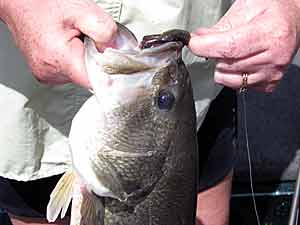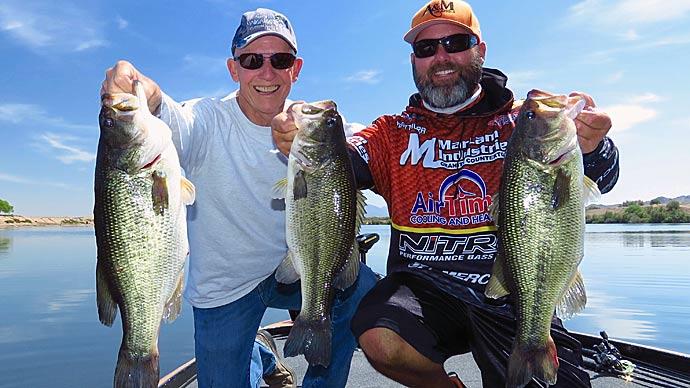
In four years as a Bassmaster Elite Series angler, 26-year-old G.Loomis pro Jonathon VanDam has become a de facto resident of the south. He spends as much time traveling in the southeast United States in search of big bass and the paychecks that come with them – as he does in his Kalamazoo, Mich. hometown. He has acquitted himself well, with two Bassmaster Classic qualifications under his belt, but his first love remains the prolific natural lakes of his native Michigan and the surrounding states. There’s a different science to breaking those waters down than there is to figuring out the big southern reservoirs that populate much of his tournament schedule.
“They tend to have a lot more fish,” he said of the northern waters. “Not necessarily the same size, but the numbers are generally better. But you have to fish them differently. A lot of northern lakes are glacial lakes. There are no roadbeds and no ledges and there are different types of weeds. It’s a totally different mindset.”
Whether you’re an absolute beginner, a weekend warrior or an aspiring pro, here are his top five tips for attacking northern waterways, regardless of the season:
Use Your Eyes
The first thing JVD does for any new body of water is map study, but nothing replaces that initial ride around eyeballing the opportunities. “You want to understand the lay of the land,” he said. “I want to know what kind of grass and structure options are available and where the baitfish are. Generally you can run across the middle of the lake and see what depth the fish are holding at and it will be pretty consistent. If you find them at 15 feet over 90, then I’ll narrow my starting spots down to areas around the 15 foot breakline.”
Decide on Largemouths or Smallmouth …or both!
Many northern waters feature both brown and green bass, and the available cover will often dictate where and how to fish for each. “If there’s more hard bottom, sand and clear water, I’ll focus on smallmouths,” JVD said. “If it’s dirtier and weedier I’ll focus on largemouths. Largemouths tend to be a little bit easier to find – they sit around weed edges and boat docks so they’re a little bit more predictable. Smallmouths are nomadic, so they don’t have to sit around anything.” He noted, however, that the rules don’t always ring true 100 percent of the time. In the New York Finger Lakes region, for example, the two species will often mix together and eat the same lures.
Go Surprisingly Shallow
Because the water stays comparatively cooler than the big southern reservoirs and the growing season is short, northern bass put on the feedbag after the spawn and stay in skinny water when the “textbook” says they should be deep. “In most June or July tournaments I’d expect fish to be super deep, in 20 to 40 feet of water,” JVD said. “I’d spend all of my time looking for isolated rock. On a lake like Champlain, though, under those same conditions they’ll often be in 10 to 14 feet, relating to grass lines, or even shallower.
Cover Water with Crankbaits
On a new body of water it’s imperative to locate the fish first, and then hunker down and figure out the big ones. JVD’s primary tool for the locating portion of the task is a crankbait. On his first day on a lake, he’ll set-up three outfits – a Shimano Curado 200I on a G.Loomis GLX855 CBR for shallow divers, a CBR 906 with a Chronarch 150CI4+ to work medium divers, and deep divers, he’ll rig those on a GLX957 CBR with a Calcutta 200D. “That gives me the full range of depth options,” he said. “I often use different lure colors than I would down south, though. The water clarity tends to be a lot better in the north so instead of standards like chartreuse with a black or blue back, I’ll start with shad, ghost minnow and bluegill type colors.”
Don’t Sleep on the Tube
Whether a lake’s primary forage is crawfish or gobies, no soft plastic catches more bass up north than a standard tube jig. In the south JVD most often fishes it on a Texas rig, with a tungsten bullet weight. “Up north, I fish it almost exclusively with a jighead inserted in it.” He favors natural colors, like pumpkins and various shades of green, but said that sometimes a gaudy color pattern can be a trigger. For example, there are occasions when a spinnerbait with a chartreuse skirt and matching blades can be the ticket to massive catches, and this applies to soft plastics as well.
Top Three Rod/Reel Combos for Northern Bass
When it comes to selecting the key rod and reel combinations to attack just any northern lake for both largemouth and smallmouth, JVD says you’ll be set with following rigs…
Crankbaits: G.Loomis CBR 906 paired with a Shimano Calcutta 200D
“This rod is the best cranking rod I’ve ever fished,” JVD said. “It’s heavy enough to cast a big crankbait, with the backbone to rip it out of the grass but it also has exactly the right action so that the hooks won’t tear free from a surging fish.” The reel’s 5.7:1 gear ratio allows substantial cranking power without overpowering the lure, while still allowing for speed when needed.
Tube: G.Loomis NRX 872S spinning rod paired with a Shimano Stradic CI4+ 2500
“I don’t use a two-power rod like this much in the south, but up north it’s just about always on my deck,” he explained. “You feel everything with that NRX and the drag system on the Stradic is perfect for a big bulldogging smallmouth.”
All-Around: G.Loomis NRX 854 JWR paired with a Shimano Metanium 100XG
“With this 7’1” four-power rod, you can do just about anything,” JVD said. “Usually the grass isn’t super thick up north, so you don’t need a heavier rod for dragging a worm or for weightless lures. The Metanium is much lighter and it’s very, very durable, and with the 8.5:1 gear ratio it’s my favorite for any sort of bottom baits.”
Don’t Make This Dropshotting Mistake
VanDam never attacks any northern natural lake without at least one dropshot combo on the deck of his boat. He said it works when fish are suspended or on the bottom, equally well for largemouths and smallmouths, and can be deadly when the bite is off.
Regardless of when or where he uses it, he said that the key is often toundersellthe presentation and to keep it subtle. “A lot of people put too much action into the bait, especially for smallmouths,” he said.
“They’re a very aggressive fish and on places like the Great Lakes and St. Clair, there’s a great deal of natural current that keeps the bait moving. Even though they’re aggressive, the bites are sometimes so subtle that it’s imperative to have a rod that’s as sensitive as possible. That’s why I like the G.Loomis NRX 822S DSR. At 6-foot-10-inches, there’s nothing better for dropshotting all day and maximizing your strike-to-hookup ratio.”




